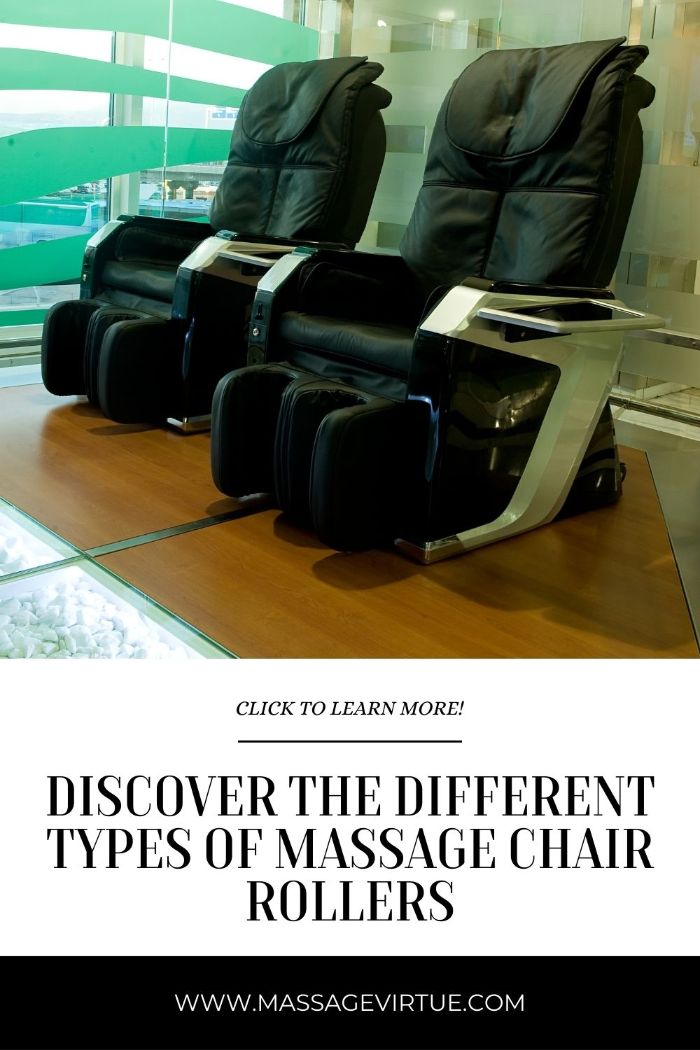Massage chairs offer a variety of features, but one essential component that determines the quality of your massage experience is the type of massage chair roller.
In this guide, we’ll explore the three primary types of massage chair rollers – 2D, 3D, and 4D – as well as other roller types such as S-track, L-track, and SL-track.
So without further ado, let’s get started.
What Are Massage Chair Rollers?
Massage chair rollers are the mechanical components within a massage chair that replicate the motions and techniques used during a professional massage.
These rollers are typically located in the backrest and are responsible for providing massage sensation and therapeutic benefits.
Massage Chair Roller Types
Massage chair rollers come in various types, such as 2D, 3D, and 4D, each offering different levels of functionality and customization. Now, let’s explore each type of massage chair roller separately to understand their unique features and benefits.
2D Massage Rollers
2D massage rollers are the most basic type of massage chair rollers. They move up and down and side to side along a two-dimensional plane.
These rollers follow a fixed track and provide a consistent level of pressure during the massage.
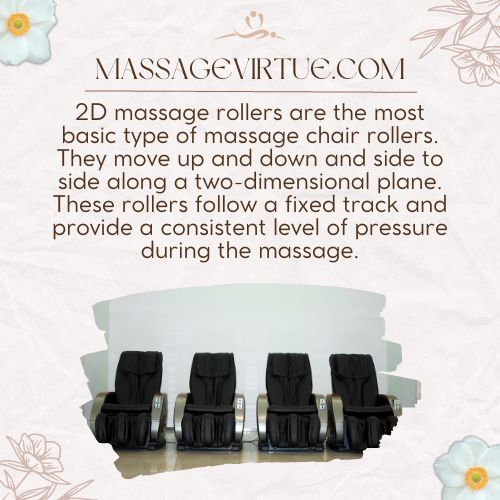
2D massage rollers work by using a combination of motorized movements and pressure to mimic the techniques of a professional masseuse.
These rollers provide a soothing and relaxing massage experience by targeting specific areas of your body.
Pros of 2D Massage Rollers
- Affordable: 2D massage chairs are generally more budget-friendly compared to other roller types.
- Simplicity: The simplicity of 2D massage rollers makes them easy to use and operate.
- Comfortable: The consistent pressure applied by 2D rollers can provide a comfortable massage experience.
Cons of 2D Massage Rollers
- Limited Depth: 2D rollers cannot penetrate deep into muscles, which may be a drawback for individuals seeking deeper tissue relief.
- Less Customization: Compared to more advanced rollers, 2D rollers offer fewer customization options.
3D Massage Rollers
3D massage rollers take the massage experience to the next level by offering additional depth and intensity control.
These rollers can move up and down, side to side, and in and out, providing a more dynamic and customizable massage.
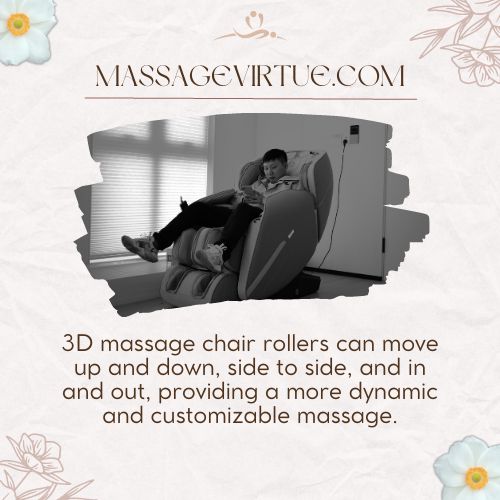
3D massage rollers work by allowing you to adjust the intensity of the rollers to suit your preference.
This feature enables the rollers to protrude further from the track, reaching deeper layers of muscle tissue for a more therapeutic massage.
Pros of 3D Massage Rollers
- Customizable Intensity: The ability to adjust the intensity of the rollers allows you to tailor the massage to your specific needs.
- Deeper Muscle Penetration: 3D rollers can reach deeper layers of muscle tissue, providing a more effective massage for pain relief.
- Versatility: 3D rollers can mimic a variety of massage techniques.
Cons of 3D Massage Rollers
- Higher Price Point: 3D massage chairs are generally more expensive than 2D rollers due to the added features and customization options.
- Learning Curve: The increased complexity of 3D rollers may require some time to fully understand and utilize all the available settings.
4D Massage Rollers
4D massage rollers represent the pinnacle of massage chair technology.
They offer all the features of 3D rollers, with the additional capability of adjusting the speed and rhythm of the massage.
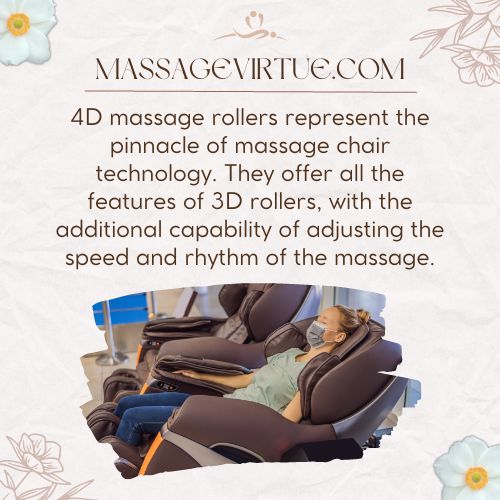
This feature allows for a more realistic and human-like massage experience.
Pros of 4D Massage Rollers
- Enhanced Customization: 4D rollers provide the highest level of customization, allowing you to adjust the speed, intensity, and rhythm of the massage.
- Realistic Massage Experience: The ability to simulate human-like massage techniques makes 4D rollers highly sought after.
- Deep Relaxation: The advanced features of 4D rollers can offer a deeply soothing and rejuvenating massage experience.
Cons of 4D Massage Rollers
- Premium Pricing: 4D massage chairs are the most expensive due to their advanced technology and extensive customization options.
- Complexity: The wide range of settings and features may require more time and effort to fully utilize and optimize.
Other Massage Roller Types
In addition to the 2D, 3D, and 4D rollers, there are other roller types available in massage chairs, including S-track, L-track, and SL-track.
S-track Rollers
S-track rollers are designed to follow an elongated S-shaped track, providing targeted massage for the lower back and buttocks.
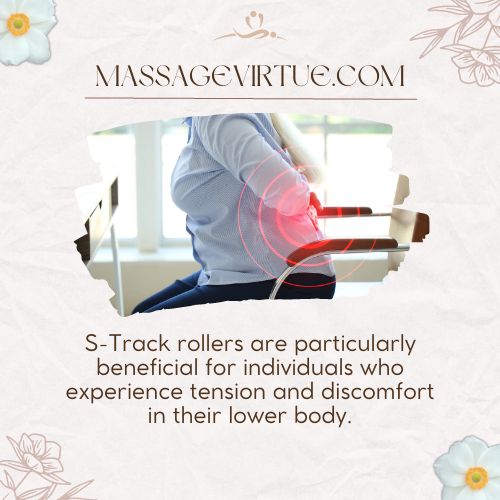
These rollers are particularly beneficial for individuals who experience tension and discomfort in their lower body.
Pros of S-Track Rollers
- Targeted Relief: S-track rollers focus on the lower back and buttocks, effectively alleviating tension and pain in those areas.
- Improved Circulation: The massage provided by S-track rollers can stimulate blood flow, promoting better circulation in the lower body.
- Enhanced Relaxation: By specifically targeting the lower body, S-track rollers offer a soothing and relaxing massage experience.
Cons of S-Track Rollers
- Limited Coverage: S-track rollers may not address tension or discomfort in the upper body, such as the back and neck regions.
- Restricted Customization: S-track rollers generally offer limited customization options compared to more advanced roller types.
L-track Rollers
L-track rollers have a shorter track compared to S-track rollers and primarily focus on massaging the back and neck regions. They are beneficial for individuals experiencing upper body tension and stress.
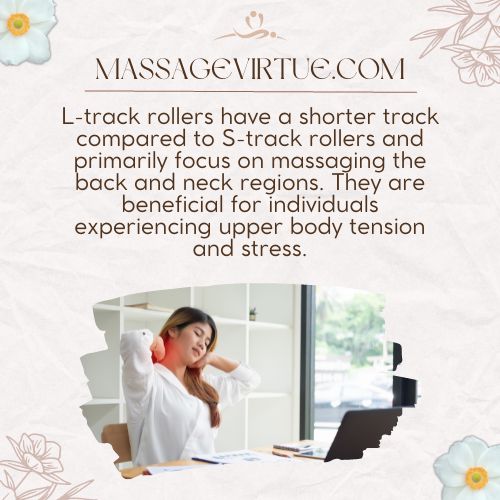
Pros of L-Track Rollers
- Upper Body Relief: L-track rollers specifically target the back and neck, providing effective relief for tension and stress in those areas.
- Versatility: L-track rollers can accommodate various body sizes and shapes, making them suitable for a wide range of users.
- Improved Posture: The massage provided by L-track rollers can help alleviate muscular imbalances and promote better posture.
Cons of L-Track Rollers
- Limited Lower Body Coverage: L-track rollers may not fully address tension or discomfort in the lower body, such as the lower back and buttocks.
- Less Comprehensive Massage: The shorter track of L-track rollers may result in a massage that is not as extensive or thorough compared to other roller types.
SL-track Rollers
SL-track rollers are an extended version of L-track rollers, combining the benefits of both S-track and L-track designs. They provide comprehensive massage coverage for the back, neck, and buttocks.
Pros of SL-Track Rollers
- Full-body Massage Coverage: SL-track rollers offer comprehensive massage coverage for the entire back, including the neck, spine, and buttocks.
- Targeted Relief: SL-track rollers can effectively address tension and discomfort in the upper and lower body, providing a more holistic massage experience.
- Versatility: SL-track rollers accommodate different body types and offer a range of massage techniques and intensities.
Cons of SL-Track Rollers
- Higher Price Range: Due to their advanced design and extended coverage, SL-track rollers tend to be more expensive compared to S-track or L-track rollers.
- Potential Complexity: SL-track rollers may have more settings and options, requiring some familiarization to optimize and customize the massage experience.
Comparison Between 2D, 3D, 4D, S-track, L-track, and SL-track.
| Roller Type | Description | Functionality | Customization | Massage Coverage | Price Range |
| 2D Rollers | Basic rollers with limited movement | Consistent pressure | Limited customization | Specific areas of the body | Affordable |
| 3D Rollers | Advanced rollers with adjustable intensity | Dynamic massage | Enhanced customization | Targets different muscle layers | Moderate to Expensive |
| 4D Rollers | State-of-the-art rollers with adjustable speed and rhythm | Intensity control | Extensive customization | Targets specific muscles with varying depths | Expensive |
| S-track Rollers | The elongated S-shaped track focuses on the lower back and buttocks | Targeted lower body massage | Limited customization | Emphasizes relief for lower back and buttocks | Varies |
| L-track Rollers | Shorter track, targets back and neck regions | Targeted upper body massage | Limited customization | Concentrates on the back and neck for relief | Varies |
| SL-track Rollers | Extended version of L-track rollers, covers the back, neck, and buttocks | Comprehensive massage coverage | Limited customization | Relief for back, neck, and buttocks | Varies |
How Roller Types Affect Massage Techniques?
In this section, we will explore how different roller types influence the massage techniques and sensations experienced during a massage chair session. Understanding these techniques will help you choose a massage chair that aligns with your specific needs and preferences.
- Kneading
- Tapping
- Rolling
- Shiatsu
- Compression
- Stretching
1. Kneading:
Kneading is a massage technique that involves circular movements with alternating pressure.
It helps relieve muscle knots, improve flexibility, and increase blood flow. Massage chairs with 2D, 3D, or 4D rollers can provide effective kneading motions, targeting specific areas of tension.
2. Tapping:
Tapping, also known as percussion, involves rapid and rhythmic tapping motions.
This technique stimulates the muscles, enhances blood circulation, and invigorates the body. Massage chairs with adjustable-speed rollers, such as 3D or 4D rollers, can deliver tapping motions with varying intensity.
3. Rolling:
Rolling is a gentle massage technique that involves continuous, rolling movements along the spine. It helps stretch and elongate the muscles, relieving tension and promoting relaxation.
Massage chairs with L-Track or S-Track rollers excel in delivering rolling motions that mimic the hands of a professional masseuse.
4. Shiatsu:
Shiatsu is a Japanese massage technique that involves applying pressure to specific points on the body.
It helps alleviate muscle pain, release tension, and restore balance. Massage chairs equipped with 3D or 4D rollers can replicate the thumb and palm pressure of a Shiatsu massage.
5. Compression:
Compression involves applying pressure to specific areas using airbags or rollers.
It aids in muscle relaxation, enhances blood circulation, and reduces swelling. Massage chairs with airbag compression rollers deliver effective compression motions to target the arms, legs, and feet.
6. Stretching:
Stretching is a technique that helps increase flexibility, improve joint mobility, and relieve muscle tightness.
Some massage chairs with advanced roller systems offer stretching programs that gently elongate and stretch the muscles, promoting overall well-being.
Maintenance and Care Tips for Massage Chair Rollers
Proper maintenance and care of your massage chair rollers are essential to ensure their longevity and optimal performance. Here are some tips to keep in mind:
- Regular cleaning
- Lubrication
- Avoid excessive weight
- Safe usage
- Professional servicing
1. Regular cleaning:
Wipe the rollers with a soft, damp cloth to remove any dirt or debris. Avoid using harsh chemicals that may damage the rollers or the upholstery.
2. Lubrication:
Follow the manufacturer’s instructions on lubricating the rollers, if required. Lubrication helps maintain smooth movements and prevents squeaking.
3. Avoid excessive weight:
Ensure that the massage chair is not subjected to excessive weight or pressure that could strain the rollers. Adhere to the weight capacity specified by the manufacturer.
4. Safe usage:
Use the massage chair according to the manufacturer’s guidelines. Avoid excessive force or movements that may put undue stress on the rollers.
5. Professional servicing:
Schedule periodic professional servicing to inspect and maintain the overall condition of your massage chair, including the rollers.
Factors to Consider When Choosing Massage Chair Rollers
Different massage chair roller types offer unique benefits and limitations, making it crucial to understand your options to choose the right one for your needs.
Here are the following factors you must consider to choose the right massage chair roller type for you:
1. Personal Preference
When choosing a massage chair, personal preference plays a crucial role. Some people may prefer a deep tissue massage, while others may prefer a lighter massage.
Some may enjoy a shiatsu-style massage while others may prefer a rolling or kneading motion. Understanding your preferences can help you determine which massage chair roller type would be the most suitable for you.
2. Health Conditions
If you have any specific health conditions or injuries, it’s essential to choose a massage chair that will not exacerbate your condition.
For example, if you have a back injury, you may want to choose a massage chair that offers a gentle massage rather than a deep tissue massage.
Similarly, if you have circulatory issues, you may want to avoid a massage chair that uses a lot of pressure.
3. Massage Needs
The type of massage you need will depend on your individual needs. For example, if you have tight muscles in your neck and shoulders, you may want a massage chair that has rollers that can target these areas specifically.
Alternatively, if you suffer from stress and anxiety you may want a massage chair that provides a relaxing massage experience.
4. Budget
Massage chairs can range in price from a few hundred dollars to several thousand dollars. It’s essential to determine how much you’re willing to spend on a massage chair and stick to your budget.
Generally, more expensive massage chairs offer more features and customization options, while cheaper chairs have more basic features.
By considering these factors and understanding the unique benefits and limitations of each massage chair roller type, you can choose the one that will provide you with the best massage experience.
Conclusion
Choosing the right massage chair roller type is crucial for a satisfying and personalized massage experience.
By understanding the differences and benefits of 2D, 3D, and 4D rollers, as well as other roller types like S-track, L-track, and SL-track, you can make an informed decision based on your specific needs and preferences.
Remember to consider factors such as pricing, customization options, and the level of relaxation and pain relief you desire.
FAQs
What is the Difference Between S and L and SL Massage Chair?
S-track massage chairs follow an elongated S-shaped track, focusing on the lower back and buttocks.
L-track massage chairs have a shorter track, targeting the back and neck regions.
SL-track massage chairs are an extended version of L-track, providing coverage for the back, neck, and buttocks.
What do 3D and 4D Mean for Massage Chairs?
3D massage chairs offer adjustable intensity, allowing the rollers to protrude further from the track for a deeper massage.
4D massage chairs have all the features of 3D rollers, with the added ability to modify the speed and rhythm of the massage for a more customizable experience.
